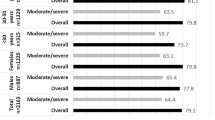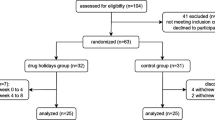Abstract
Purpose
Selective serotonin reuptake inhibitors are associated with high rates of nonadherence and sexual dysfunction, yet the correlation between these findings in young adult men is poorly characterized. We aimed to evaluate if young adult men are less willing to adhere to antidepressant treatment due to intolerable side effects, such as sexual dysfunction.
Methods
Deidentified, compensated survey that assessed baseline demographics, PHQ-8 and GAD-7 scores, attitudes towards antidepressant medication side effects, and perceptions of antidepressant medications including selective serotonin reuptake inhibitors, bupropion, and mirtazapine.
Results
From 665 delivered surveys, 505 respondents completed their survey (response rate: 76%), of which 486 were included for final analysis. After seeing common side effect profiles, our sample’s willingness to take sexual function-sparing agents, such as bupropion or mirtazapine, was significantly greater than selective serotonin reuptake inhibitors (p < 0.001), with no significant difference between bupropion and mirtazapine (p = 0.263). The negative influence of erectile dysfunction and anorgasmia scored significantly higher than other common antidepressant side effects like weight gain, nausea, and dry mouth (range: p < 0.001, p = 0.043). With the exception of insomnia, participants indicated that experiencing sexual dysfunction while taking an antidepressant medication would lead to nonadherence at a significantly higher frequency than any other side effect assessed (range: p < 0.001, p = 0.005).
Conclusion
The risk of experiencing sexual side effects when taking antidepressants could lead young adult men to become nonadherent to these medications. Strategies to augment the effectiveness of antidepressants, such as shared decision-making and the use of sexual function-sparing agents, are critical.


Similar content being viewed by others
Data availability
The data that support the findings of this study are available on request from the corresponding author.
References
Wiens K, Bhattarai A, Pedram P et al (2020) A growing need for youth mental health services in Canada: examining trends in youth mental health from 2011 to 2018. Epidemiol Psychiatr Sci 29:e115. https://doi.org/10.1017/S2045796020000281
Barker MM, Beresford B, Bland M, Fraser LK (2019) Prevalence and incidence of anxiety and depression among children, adolescents, and young adults with life-limiting conditions: a systematic review and meta-analysis. JAMA Pediatr 173(9):835–844. https://doi.org/10.1001/jamapediatrics.2019.1712
Pirraglia PA, Stafford RS, Singer DE (2003) Trends in prescribing of selective serotonin reuptake inhibitors and other newer antidepressant agents in adult primary care. Prim Care Companion J Clin Psychiatry 5(4):153–157. https://doi.org/10.4088/pcc.v05n0402
Demyttenaere K, Enzlin P, Dewé W et al (2001) Compliance with antidepressants in a primary care setting, 1: beyond lack of efficacy and adverse events. J Clin Psychiatry 62(Suppl 22):30–33
Cantrell CR, Eaddy MT, Shah MB, Regan TS, Sokol MC (2006) Methods for evaluating patient adherence to antidepressant therapy: a real-world comparison of adherence and economic outcomes. Med Care 44(4):300–303. https://doi.org/10.1097/01.mlr.0000204287.82701.9b
Olfson M, Marcus SC, Tedeschi M, Wan GJ (2006) Continuity of antidepressant treatment for adults with depression in the United States. Am J Psychiatry 163(1):101–108. https://doi.org/10.1176/appi.ajp.163.1.101
Sansone RA, Sansone LA (2012) Antidepressant adherence. Innov Clin Neurosci 9(5–6):41–46
Ramic E, Prasko S, Gavran L, Spahic E (2020) Assessment of the antidepressant side effects occurrence in patients treated in primary care. Mater Sociomed 32(2):131–134. https://doi.org/10.5455/msm.2020.32.131-134
Huang X, Lu Y, Luo S, Wang F, Xie Z, Wang X (2009) Efficacy and safety of selective serotonin re-uptake inhibitors in the treatment of premature ejaculation: a systematic evaluation. Zhonghua Nan Ke Xue 15(3):248–255
Serretti A, Chiesa A (2009) Treatment-emergent sexual dysfunction related to antidepressants: a meta-analysis. J Clin Psychopharmacol 29(3):259–266. https://doi.org/10.1097/JCP.0b013e3181a5233f
Jing E, Straw-Wilson K (2016) Sexual dysfunction in selective serotonin reuptake inhibitors (SSRIs) and potential solutions: a narrative literature review. Ment Health Clin 6(4):191–196. https://doi.org/10.9740/mhc.2016.07.191
Zimmerman M, Posternak MA, Attiullah N et al (2005) Why isn’t bupropion the most frequently prescribed antidepressant? J Clin Psychiatry 66(5):603–610. https://doi.org/10.4088/jcp.v66n0510
Stahl SM (2021) Stahl’s essential psychopharmacology: neuroscientific basis and practical applications, 5th edn. Cambridge University Press, Cambridge
Lynch L, Long M, Moorhead A (2018) Young men, help-seeking, and mental health services: exploring barriers and solutions. Am J Mens Health 12(1):138–149. https://doi.org/10.1177/1557988315619469
Suicide Data and Statistics | Suicide | CDC. Published 06 April 2023. https://www.cdc.gov/suicide/suicide-data-statistics.html. Accessed 01 May 2023
Seidler ZE, Dawes AJ, Rice SM, Oliffe JL, Dhillon HM (2016) The role of masculinity in men’s help-seeking for depression: a systematic review. Clin Psychol Rev 49:106–118. https://doi.org/10.1016/j.cpr.2016.09.002
Sussman N, Ginsberg DL, Bikoff J (2001) Effects of nefazodone on body weight: a pooled analysis of selective serotonin reuptake inhibitor- and imipramine-controlled trials. J Clin Psychiatry 62(4):256–260
Cascade E, Kalali AH, Kennedy SH (2009) Real-world data on SSRI antidepressant side effects. Psychiatry (Edgmont) 6(2):16–18
DailyMed—WELLBUTRIN XL- bupropion hydrochloride tablet, extended release. https://dailymed.nlm.nih.gov/dailymed/drugInfo.cfm?setid=a435da9d-f6e8-4ddc-897d-8cd2bf777b21. Accessed 15 September 2021
Fava M, Rush AJ, Thase ME et al (2005) 15 Years of clinical experience with bupropion HCl: from bupropion to bupropion SR to bupropion XL. Prim Care Companion J Clin Psychiatry 7(3):106–113
Settle EC, Stahl SM, Batey SR, Johnston JA, Ascher JA (1999) Safety profile of sustained-release bupropion in depression: results of three clinical trials. Clin Ther 21(3):454–463. https://doi.org/10.1016/s0149-2918(00)88301-0
Hartmann PM (1999) Mirtazapine: a newer antidepressant. AFP 59(1):159
Jilani TN, Gibbons JR, Faizy RM, Saadabadi A (2022) Mirtazapine. In: StatPearls. StatPearls Publishing, Treasure Island. http://www.ncbi.nlm.nih.gov/books/NBK519059/. Accessed 24 January 2022
Kroenke K, Strine TW, Spitzer RL, Williams JBW, Berry JT, Mokdad AH (2009) The PHQ-8 as a measure of current depression in the general population. J Affect Disord 114(1):163–173. https://doi.org/10.1016/j.jad.2008.06.026
Sapra A, Bhandari P, Sharma S, Chanpura T, Lopp L (2020) Using generalized anxiety disorder-2 (GAD-2) and GAD-7 in a primary care setting. Cureus 12(5):e8224. https://doi.org/10.7759/cureus.8224
Lam RW, Kennedy SH, Grigoriadis S et al (2009) Canadian network for mood and anxiety treatments (CANMAT) clinical guidelines for the management of major depressive disorder in adults: III. Pharmacotherapy. J Affect Disord 117:S26–S43. https://doi.org/10.1016/j.jad.2009.06.041
Lorenz T, Rullo J, Faubion S (2016) Antidepressant-induced female sexual dysfunction. Mayo Clin Proc 91(9):1280–1286. https://doi.org/10.1016/j.mayocp.2016.04.033
Acknowledgements
We thank the Sexual Medicine Society of North America for their generous “Scholars in Sexuality Research Grant” award enabling the creation of this work. We would also like to recognize Dr. James Aluri and Dr. Vinay Parekh for their contribution to the conceptualization of this project from the Department of Psychiatry. We also recognize the Johns Hopkins University Biostatistics, Epidemiology and Data Management (BEAD) Core for their assistance. Finally, we thank Dr. Dolores Lamb and Dr. Arthur Burnett for their invaluable mentorship and guidance throughout the duration of this project.
Funding
This project was funded by the 2022 SMSNA Scholars in Sexuality Research Grant Program (PI: Matthew Rabinowitz; Grant Title: Anti-Depressant Non-adherence and the Prioritization of Sexual Function in Young Men) and generous philanthropic donations from patients of Dr. Amin Herati.
Author information
Authors and Affiliations
Contributions
M. J. Rabinowitz: Protocol/project development; Data Analysis; Manuscript writing/editing. O. Li: Data collection or management; Manuscript writing/editing. E. Pi: Data collection or management; Manuscript writing/editing. C. K. Eaton: Protocol/project development; Data collection or management; Data Analysis; Manuscript writing/editing. T. P. Kohn: Protocol/project development; Manuscript writing/editing. N. M. Haney: Manuscript writing/editing. A. S. Herati: Protocol/project development; Manuscript writing/editing.
Corresponding author
Ethics declarations
Conflict of interest
The authors have no relevant financial or non-financial interests to disclose.
Additional information
Publisher's Note
Springer Nature remains neutral with regard to jurisdictional claims in published maps and institutional affiliations.
Supplementary Information
Below is the link to the electronic supplementary material.
Rights and permissions
Springer Nature or its licensor (e.g. a society or other partner) holds exclusive rights to this article under a publishing agreement with the author(s) or other rightsholder(s); author self-archiving of the accepted manuscript version of this article is solely governed by the terms of such publishing agreement and applicable law.
About this article
Cite this article
Rabinowitz, M.J., Li, O., Pil, E.H. et al. Antidepressant nonadherence and sexual dysfunction among young adult males: the cross-sectional YAMAN study. World J Urol 42, 295 (2024). https://doi.org/10.1007/s00345-024-05003-3
Received:
Accepted:
Published:
DOI: https://doi.org/10.1007/s00345-024-05003-3




